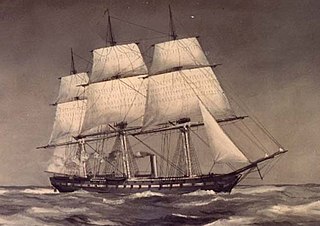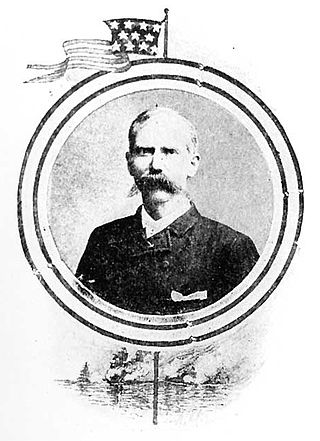
USS Minnesota was a wooden steam frigate in the United States Navy. Launched in 1855 and commissioned eighteen months later, the ship served in east Asia for two years before being decommissioned. She was recommissioned at the outbreak of the American Civil War and returned to service as the flagship of the North Atlantic Blockading Squadron.

USS Wabash was a steam screw frigate of the United States Navy that served during the American Civil War. She was based on the same plans as Colorado. Post-war she continued to serve her country in European operations and eventually served as a barracks ship in Boston, Massachusetts, and was sold in 1912.

USS Commodore Perry was a 512-long-ton (520-tonne) steamer acquired by the Union Navy in 1861, the first year of the American Civil War. She was named after Commodore Oliver Hazard Perry (1785–1819), a naval officer who had commanded American forces on Lake Erie in the War of 1812. In January–February 1862, Commodore Perry was part of the North Atlantic Blockading Squadron, taking part in the attack, in cooperation with the Union Army, which resulted in the surrender of Roanoke Island by the Confederate States of America. She participated in several other campaigns through 1862, including the capture of Elizabeth City, North Carolina, and army–navy expeditions against Franklin, Virginia, and Hertford, North Carolina. From 1863 until the end of the war, she was engaged in patrols, both inland and in Virginia coastal waters.

USSWhitehead, a screw steamer built in 1861 at New Brunswick, New Jersey, served as a gunboat in the United States Navy during the American Civil War.
James Stoddard was a Union Navy sailor in the American Civil War and a recipient of the United States military's highest decoration, the Medal of Honor, for his actions during an engagement in Yazoo City, Mississippi.
Bartlett Laffey was an Irish-born United States Navy sailor and Medal of Honor recipient.
William Joseph Franks was a United States Navy sailor who received the Medal of Honor for his actions in the American Civil War.

Robert Blake was a Union Navy sailor during the American Civil War and a recipient of America's highest military decoration, the Medal of Honor. Blake was the second African American to perform a Medal of Honor action; William Harvey Carney was the first. Blake was the first African American to actually receive a Medal of Honor - his was presented to him in 1864, while Carney did not receive his until 1900. But, because Carney's Medal of Honor action occurred first, Carney, not Blake, is usually credited with being the first African American Medal of Honor recipient.

The Joint Expedition Against Franklin was a joint engagement between the United States Army and Navy against the Confederate States Army during the American Civil War. The engagement was intended to move Union forces into an area where Confederate forces were gathering as they prepared to move on Suffolk, Virginia. Originally planned as a coordinated two-pronged attack with a naval flotilla supporting an infantry advance on Franklin, Virginia, communications delays caused the Union Navy to start the mission before the Army was ready to support it. Instead, October 3, 1862 found Union Naval forces on the Blackwater River greatly outnumbered by Confederate infantrymen and ultimately forced to retreat. The naval action alone is also known as the Action at Crumpler's Bluff or the Battle of Crumpler's Bluff.

William D. Newland was a United States Navy sailor and a recipient of America's highest military decoration—the Medal of Honor—for his actions in the American Civil War.
Michael Connelly was a United States Navy sailor and a Medal of Honor recipient for his role in the American Civil War. He served under the name John Mack.
Daniel Lakin was a Medal of Honor recipient in the Union Navy from 1861–1865
John S. Lanning was a Union Navy sailor and a Medal of Honor recipient for his actions in the American Civil War. He served under the name John S. Lann.
Edwin Smith was a Union Navy sailor in the American Civil War and a recipient of the U.S. military's highest decoration, the Medal of Honor, for his actions during the Joint Expedition Against Franklin.
George Pyne was a Union Navy sailor in the American Civil War and a recipient of the U.S. military's highest decoration, the Medal of Honor, for his actions at the Battle of Natural Bridge.
John Williams was a Union Navy sailor in the American Civil War and a recipient of the U.S. military's highest decoration, the Medal of Honor, for his actions during the Joint Expedition Against Franklin.

Charles Robinson was a Union Navy sailor in the American Civil War and a recipient of the U.S. military's highest decoration, the Medal of Honor, for his actions during an expedition on the Yazoo River.
Thomas S. Flood was a Union Navy sailor in the American Civil War and a recipient of the U.S. military's highest decoration, the Medal of Honor, for his actions at the Battle of Forts Jackson and St. Philip.
John B. Frisbee was a Union Navy sailor in the American Civil War and a recipient of the U.S. military's highest decoration, the Medal of Honor, for his actions at the Battle of Forts Jackson and St. Philip.
Boatswain's Mate John Breen was an Irish soldier who fought in the American Civil War. Breen received the United States' highest award for bravery during combat, the Medal of Honor, for his action at Petersburg, Virginia on 3 October 1862. He was honored with the award on 3 April 1863.








